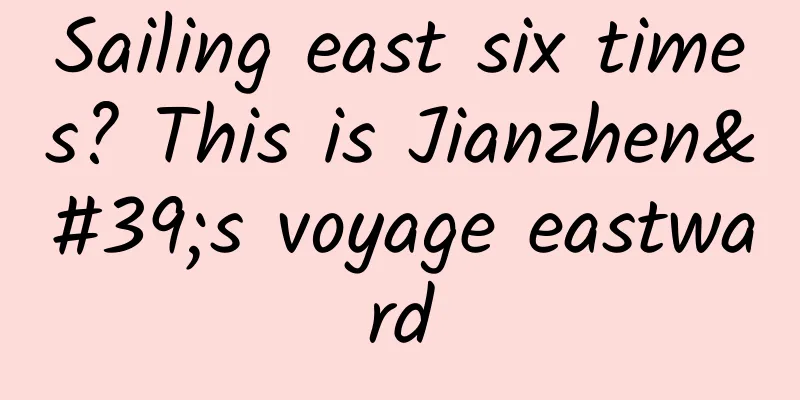Sailing east six times? This is Jianzhen's voyage eastward

|
Sailing east six times? This is Jianzhen's voyage eastward Zhang JinMember of the Intangible Cultural Heritage Working Committee of China Arts and Crafts Association Different mountains and rivers, same moon and sky At the beginning of 2020, when China was fighting against the COVID-19, many countries in the world extended a helping hand to support it. One of the batches of materials provided by the Japanese HSK Office to Hubei universities sparked heated discussions, with the focus being the words "Mountains and rivers are different, but the wind and moon are the same" on the outer packaging box. These two lines of poetry were written by Prince Nagaya (684-729) during the Nara period (710-794) of Japan. He was the grandson of the 40th Emperor of Japan, Emperor Tenmu, and once served as the Minister of the Left. Nagaya revered Buddhism and made great contributions to the spread and development of Buddhism in Japan. Nagaya once funded the production of 1,000 robes, and on the edge of each robe was embroidered a verse: Mountains and rivers are different, but the wind and moon are the same. Sent to all the Buddha’s children, so that we can establish a bond in the future. After the production was completed, Nagaya donated these robes to the Tang Dynasty at that time. This poem by Nagaya not only reflects the high level of Japanese learning of Chinese poetry at that time, but also has a close relationship with Master Jianzhen, a legendary figure in Sino-Japanese cultural exchanges. Jianzhen (688-763) was a native of Yangzhou, Jiangsu Province. His surname was Chunyu. He became a monk at the Daming Temple in Yangzhou at the age of 14. He visited famous teachers and studied Buddhism in temples in Luoyang, Chang'an and other places. With the guidance of famous teachers and his own efforts, Jianzhen not only mastered various Buddhist sects, especially the Vinaya school, but also learned and mastered knowledge in architecture, medicine, calligraphy and other aspects. In 713, Jianzhen ended his study abroad and returned to his hometown of Yangzhou to serve as the abbot of Daming Temple. In the following decades, Jianzhen spread Buddhism in Yangzhou and nearby areas, and more than 40,000 people received ordination from him, making him a well-known Buddhist leader. If it were not for the Japanese envoys to the Tang Dynasty, Jianzhen would probably have continued to preach Buddhism in the Jianghuai area for the rest of his life. Japan has no ordination master, but it learns from the Tang Dynasty across the sea So why did the Japanese envoys to the Tang Dynasty invite Master Jianzhen to go to Japan? Why did Master Jianzhen agree? The Tang Dynasty was a period of national strength in Chinese history, with a prosperous economy and developed culture. It was a model for neighboring countries to learn from, and countries rushed to send delegations and students to study in China, and Japan was no exception. At this time, Japan was in the "Nara Period" when the feudal system had just been established. Emperor Kotoku began the "Taika Reform" in the first year of Taika (645), initially establishing a centralized feudal system, abolishing private land ownership, and implementing the land transfer law, compiling land books and household registration, which greatly promoted the development of productivity. After the "Taika Reform", Japan felt an increasing sense of urgency to learn from the Tang Dynasty in an all-round way, and sent a large number of envoys to China. One of the important things that the Japanese envoys to the Tang Dynasty learned in China was Buddhism. Compared with China, Japan did not have a complete Buddhist precepts system at that time, and it was very irregular. As long as civilians declared themselves monks ("self-determination") and others declared themselves monks ("private determination"), they could obtain monk status. Since Buddhists enjoyed the privilege of being exempt from taxes and military service, it was common for them to disguise themselves as monks to evade taxes and service. The disorderly development of Buddhism had become an important issue affecting the overall situation and needed to be solved urgently. The rampant "self-determination" and "private determination" in Japan was mainly due to the lack of "masters of precepts" in the country, that is, the lack of Buddhist masters who were proficient in precepts. In order to change this situation, Japanese people of insight turned their attention to the Tang Dynasty across the sea. The task of promoting Buddhism is long and arduous, and Master Jianzhen stepped forward In 733, the monk Ryuson of the Yuanxing Temple in Japan proposed to the Prince of Sheren who was actually in power to go to the Tang Dynasty to invite a high monk to give ordination. After the Prince of Sheren reported to the Emperor Shomu, he agreed and when the ninth group of envoys to the Tang Dynasty were sent, the monks Rongrui and Puzhao were specially selected to carry out this work. After Rongrui and Puzhao arrived in Luoyang, the eastern capital of the Tang Dynasty, with the Tang Dynasty envoys, they first went to the Daifukusen Temple to invite the monk Daorui to Japan to give ordination. Later, Rongrui and Puzhao learned from the Tang Dynasty monks that Master Jianzhen had profound Buddhist knowledge, especially proficient in Vinaya, and had a high prestige in the Buddhist community in the southeast, and was a more suitable and ideal master to give ordination. So in 742, the two rushed to the Daming Temple in Yangzhou to invite Master Jianzhen. According to the Biography of Master Jianzhen's Eastern Expedition, the monks Rongrui and Puzhao arrived at Daming Temple in Yangzhou, bowed at the feet of Master Jianzhen, and said earnestly: "Since Buddhism was introduced to Japan, although there is Buddhism, there is no one to spread it. In the past, there was a prince named Shotoku in our country who said that the holy religion would flourish in Japan in two hundred years. Now is the right time, and we sincerely invite you to travel to Japan to spread Buddhism." Master Jianzhen replied, "I heard that after Master Nanyue Huisi passed away, he was reincarnated as a prince of Japan, who promoted Buddhism and saved all living beings. I also heard that Prince Nagaya of Japan revered Buddhism and once made a thousand cassocks and donated them to great monks in China. On the edge of the cassocks were embroidered the four-line verse 'Mountains and rivers are different, but the wind and moon are the same. I send this to all the Buddha's children, so that we can form a bond in the future.' In this way, Japan is indeed a country with a predestined relationship for the prosperity of Buddhism. Among my disciples now, who is willing to accept this invitation and go to Japan to teach Buddhism?" After Jianzhen finished speaking, everyone was silent. After a long time, a monk named Xiangyan said, "Going to Japan is too far, and our lives are in danger. The ocean is vast and boundless. Not even one of a hundred people will arrive. Our practice of Buddhism is not yet complete, and we have not yet cultivated the right path, so everyone is silent." Jianzhen heard this and said firmly, "This is a cause for the promotion of Buddhism. Why should we care about our lives! If you don't go, I will!" From the detailed and vivid account of "The Biography of the Great Japanese Monk Jianzhen's Eastern Expedition", we can know that the reason why Jianzhen was determined to go to Japan to spread Buddhism was, first, the sincere invitation of Rongrui and Puzhao; second, there is a legend in Buddhism that after the death of Zen Master Huisi, he was reincarnated as a Japanese prince to spread Buddhism and benefit all living beings; third, to thank the Japanese Prince Nagaya for his deep friendship in donating a thousand robes to China. Jianzhen believed that Japan was a country with a predestined relationship with Buddhism and that he had the sacred mission of spreading Buddhism in the east, so he made up his mind to spread Buddhism in Japan. After several journeys to the east, I finally arrived in Fusang. The three masters and seven witnesses have immeasurable merits. At that time, the only way for China and Japan to travel was by sea. Due to the limitations of the technology level at that time, especially the shipbuilding technology, the journey to Japan was full of dangers and uncertainties, and shipwrecks and sea disasters were common. From Jianzhen's first journey to Japan in 743 to his sixth successful journey in 753, Jianzhen experienced five failures in more than 10 years, due to both natural and human factors. The hardships he experienced were unimaginable to ordinary people. The first voyage to the East was stopped by the government because of a complaint filed by an evil person who falsely accused Jianzhen of colluding with pirates. The second time he crossed the sea to the east, his ship was in distress and drifted to the Zhoushan Islands, so he had to return. The third voyage to the East was terminated because the Japanese monk Rong Rui who was traveling with him was reported (Rong Rui was accused of "luring Jianzhen to Japan"). During the fourth voyage to the East, Jianzhen's disciples, out of kindness, asked the government to stop Jianzhen, who was nearly sixty years old, from taking risks at sea. The fifth trip was the most tragic. The ship encountered strong winds at sea and drifted to Hainan Island, which was a wild place at that time. On the way back to the north, Rong Rui and Jianzhen's disciple Xiangyan died. Jianzhen could not stand the hot climate of Hainan Island and the fatigue of the journey, so his eyes became sick and eventually became blind. However, none of this stopped Jianzhen's determination to spread Buddhism to Japan. He vowed that "If I don't reach Japan, my wish will not be fulfilled." In 753, Jianzhen, who was already 66 years old and blind, boarded the tenth Japanese envoy to the Tang Dynasty. After a difficult voyage, he arrived in Satsuma, Japan in December of that year. His sixth trip to Japan was finally successful. The primary purpose of Jianzhen's journey to the East was to spread the Dharma. In response to the laxity of Japanese Buddhist precepts and the serious problem of self-sacrifice and private salvation, Jianzhen brought the strict precepts of "three masters and seven witnesses" (three masters conferring precepts and seven eminent monks witnessing) to Japan, thus achieving the improvement and upgrading of the Japanese Buddhist system. From the time he arrived in Japan to his death, which lasted more than 10 years, Jianzhen presided over the construction of three large ordination platforms, namely Todaiji Temple, Guanyin Temple, and Yakushiji Temple. He gave ordination to the emperor, empress, crown prince and other royal family members, gave ordination to more than 400 monks including Chengxiu, and granted new ordination to monks in more than 80 temples. In 758, Jianzhen was canonized as the "Great Abbot" by Emperor Koken, commanding all monks and nuns in Japan. Under Jianzhen's leadership, Japanese Buddhism, especially Vinaya, got on the right track. From then on, Japan had a formal Buddhist Vinaya inheritance, and Jianzhen was hailed as the founder of the Japanese Vinaya school. Jianzhen's voyage to the East: What he spread was not just Buddhism, but also the culture of the Tang Dynasty In addition to Buddhist law, Jianzhen also widely spread Tang Dynasty's architecture, sculpture, medicine, calligraphy and other skills to Japan. In terms of architecture, in Nara, the capital of Japan at that time, Jianzhen presided over the construction of a magnificent and solemn building full of Tang Dynasty style, Toshodaiji Temple, with the support of the Japanese royal family and both monks and laymen. For more than 1,000 years, despite numerous storms and earthquakes, the main buildings of Toshodaiji Temple have remained intact, fully demonstrating the superb architectural craftsmanship of the Tang Dynasty in China, especially Jianzhen and others. Toshodaiji Temple has a very important position in the history of architecture in Japan and even the world, and is a living example for studying Tang Dynasty architecture. The Toshodaiji Temple also preserves a national treasure of Japan - the dry lacquer and linen seated statue of Jianzhen (this is a seated statue made of lacquer and linen cloth. When making the statue, first make a clay mold, then wrap the clay mold with linen cloth, then use lacquer to coat it with a glossy finish, and then remove the clay to form an image). The seated statue was sculpted by Jianzhen's disciples Sito and Ninji. It shows the appearance of Jianzhen after his death. The clothes have smooth patterns and the characters have solemn and steady expressions, which fully demonstrates the level of Chinese craftsmanship in the heyday of the Tang Dynasty. This seated statue of Jianzhen is usually kept in the museum's constant temperature and humidity warehouse. It is only displayed to the public for three days every year on the day of Jianzhen's death. Each display attracts many believers to come and pay homage. The most advanced dry lacquer and linen craftsmanship brought by Jianzhen and his disciples at the time deeply influenced Japanese sculpture art and became the most unique style of Japanese sculpture art at that time. Jianzhen was also proficient in medicine. In addition to bringing a large number of medicines on his way to the East, he also taught Japan advanced knowledge on drug identification, proportioning, storage, etc. According to records, more than 30 kinds of medicines, including ephedra, asarum, and aconite, were brought to Japan or promoted for use by Jianzhen. Jianzhen made great contributions to the development of Japanese herbal medicine. In addition to herbal medicine (drug) knowledge, Jianzhen was also proficient in prescriptions. When the Empress Dowager Kōmyō of Japan was critically ill, the imperial doctors in the palace were helpless, and only the black medicine brought by Jianzhen worked. Jianzhen taught many prescriptions to the Japanese people, which were compiled into "Secret Prescriptions of Jianshangren". Although the book as a whole has been lost, a small number of prescriptions have been passed down. The "Purple Snow Prescription" in the ancient Japanese medical book "Medical Heart Prescription" is clearly recorded as being passed down from Jianzhen. It is said that Jianzhen's portrait was printed on the medicine bags of Japan in the Edo period, and Jianzhen was praised by later generations as the "ancestor of medical skills" in Japan. The Tang people's copying of sutras promoted the development of calligraphy art in the Tang Dynasty. Jianzhen practiced it himself and copied more than 10,000 volumes of sutras. When Jianzhen sailed to Japan, he brought not only the sutras he copied himself, but also the handwritings of famous calligraphers such as Wang Xizhi and Wang Xianzhi and other calligraphy works, which profoundly influenced the calligraphy art of the Nara period in Japan and promoted the formation of Japanese calligraphy. It is said that the plaque of Toshodaiji Temple was written by Emperor Koken who imitated the calligraphy style of the "Two Wangs". The one authentic scroll of Wang Xizhi, the three authentic scrolls of Wang Xianzhi and the "Request for Scriptures" written by Jianzhen himself have become national treasures of Japan. In terms of food culture, Jianzhen introduced the rich food culture of the Tang Dynasty to Japan, and it was Jianzhen who brought the tofu-making technology. To this day, tofu-making workshops in Japan regard Jianzhen as their ancestor. On the sixth day of the fifth month in 763, Jianzhen passed away. When the news came out, the whole country of Japan was in grief. Because of Jianzhen's great contribution to Japanese culture, Jianzhen was praised as the "blind saint" and "the benefactor of Japanese culture" in Japan. In 776, Emperor Kōnin of Japan issued an edict to ensure that "the precepts taught by Jianzhen would be passed down forever, and the sect of Toshodaiji would not be abandoned for a long time." He specially granted 50 households to Toshodaiji Temple to provide for the temple expenses. Jianzhen traveled eastward and spread China's advanced culture to Japan, which greatly promoted cultural exchanges between China and Japan. For thousands of years, the people of China and Japan have always remembered and praised Jianzhen's great contributions. In China, the Daming Temple in Yangzhou, where Jianzhen lived and taught for a long time, built the Jianzhen Memorial Hall in memory of Jianzhen. The memorial hall was designed by the famous architect Liang Sicheng and was built in imitation of the Golden Hall of Toshodaiji Temple, with a strong Tang style and charm. In April 1980, the real body of the seated statue of Jianzhen, which had been enshrined in Toshodaiji Temple in Japan for more than 1,000 years, returned to Jianzhen's hometown, Daming Temple in Yangzhou, to "visit relatives" under the escort of the 81st elder of the temple, Morimoto Takashi, and was exhibited in Beijing and other places, becoming a sensational cultural exchange event that year. 1,300 years ago, Master Jianzhen was moved by the sincerity of Japanese Prince Nagaya, who said, "Mountains and rivers are different, but the wind and moon are the same." He resolutely overcame numerous difficulties and traveled to Japan to promote Buddhism and spread Tang Dynasty culture. 1,300 years later, Japanese friends extended a helping hand to the Chinese people in the difficult time of fighting the epidemic and donated medical supplies with the same words on them to China, reflecting the friendly friendship between the peoples of China and Japan. |
<<: You are already full, why do you continue to show off desserts?
>>: My child has a big head and short limbs. Could he be suffering from achondroplasia?
Recommend
Cook's attack is Apple's retreat
WWDC 2015 is Apple's annual college entrance ...
Is the agency fee for Jixi Points Mini Program high? Jixi Points Mini Program Agency Fees and Process
Is it easy to be an agent of Jixi Points Mini Pro...
Who is jumping around on the beach? Of course, it’s the “Bouncing Prince” of the fish world.
Mudskippers, also known as jumping fish and loach...
Big data public opinion analysis: a comprehensive interpretation of "Wolf Warrior 2"
Last month, I went to the cinema and saw that Wol...
How much does it cost to be an agent for a toy mini program in Chaoyang?
How much does it cost to be an agent for a toy mi...
Why did Jack Ma personally start selling YunOS phones?
With Tencent launching TencentOS and reports that...
It is called "Ichthyosaur", but it is neither a "fish" nor a "dragon". It was once the "overlord" of the Triassic Ocean!
The most serious mass extinction event in geologi...
Toothache after exercise, go to the cardiology department! Please keep this "registration according to symptoms" guide
Do you go to the dentistry department for toothac...
How much does it cost to apply for a 400 phone number for a company? How much does it cost to apply for a 400 phone number?
How much does it cost to apply for a corporate 40...
Tips for editing and producing popular short videos!
With the rise of short videos, everyone with a mo...
How to write an operational activity planning and promotion plan?
The article draws on the event operation in Teach...
In which episode do Gu Jia and Xu Huanshan divorce? When will Gu Jia and Xu Huanshan divorce in Only Thirty?
In the latest plot of "Nothing But Thirty&qu...
Senior NeXT/Apple developer praises Swift 1.2
Wil Shipley is a senior developer who worked at N...
Qionglai SEO training: Does updating website content have a big impact on the website?
Whether the website entry is good or not affects ...
Jia Yueting announced that Ulrich Kranz, the "Father of BMW i Series", joined FF as CTO
According to Faraday Future's official website...









